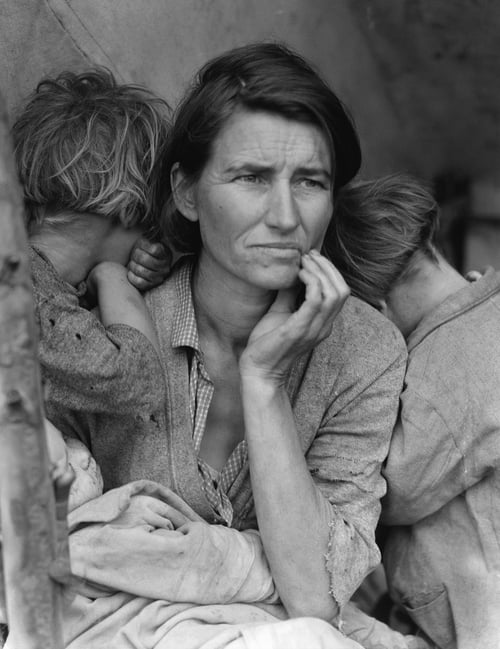There are so many little tips and tricks I like to use in landscape photography to make my life easier, and I’ve included nine of the most important in the article and video below. I’m focusing especially on composition, but there are some post-processing and camera-related tips as well. My hope is that some of these techniques are new to you, and that you find them valuable for your own work.
First up, the video:
And below is a modified script that covers all nine points in detail:
Table of Contents
Flip Your Photos Horizontally
The first time is my favorite one: flip your photos horizontally, and then flip them back.
Why would you do that? Quite simply, it lets you see your photos with a new eye.
I can’t demonstrate this by showing you my own photos, because you haven’t been looking at them for hours on end. Here, though, are a few famous images flipped horizontally. The longer you’ve looked at them before, the more unusual these mirror images will look:
Now take your own photos – your best photos – and flip them horizontally, too. I guarantee that you will see them in a different light. Countless times, this trick has helped me straighten landscape photos that are crooked, crop them to make my message stronger, or even change the elements that I brighten and darken to emphasize in the photo.
Bookend Your Panoramas
The second tip is just something that makes your life easier as a photographer and saves time. If you ever take panoramas or HDR photos in the field, you should do something called bookending your photos. This just means at the beginning of your panorama, take a photo of your hand. Then do everything like normal, finish the panorama, and take another photo of your hand.
The reason is simple. When you’re sorting through your photos later, it can be a huge waste of time to figure out where one panorama ends and the next begins. If you bookend your photos, you never have to think about it. You know exactly where each one starts.
Wait for Patterns
The natural world is filled with patterns. If you miss a good photo – the right moment passes you by – there is an extremely high chance that you’ll have a second opportunity to get the shot. It might take fifteen minutes. It might not happen until tomorrow. But almost everything in nature repeats itself: light, weather, and moving subjects like waves in the ocean.
I once spent an amazing sunrise doing photography from the top of a hill. Right after I left, a rainbow appeared where I had been shooting. It faded before I could capture a photo, but I went back to the same spot, and thirty minutes later, another one appeared. I got the shot below because I waited around for the pattern to happen again.

Embrace the Refining Process
One of my main methods of taking landscape photos is something I call the refining process.
Your time in the field is your best chance to fix any problems, so use it wisely. I’m not just talking about reviewing your photo to double-check sharpness; I’m talking about composition. Take the time to analyze the composition you just got. There is almost always something that can be fixed. Find it and fix it while you can.




Unify the Message of Your Photo
To take the strongest possible photos, it’s important that as many elements as possible in an image add to your message.
For example, if you have dark, high-contrast lighting with an intense subject, your entire photo is unified. But that won’t always be the case. Take a look at the photo below:
By all normal standards, the subject is interesting, and the light is beautiful. But somehow this photo just doesn’t work. Why not? It doesn’t send a unified message.
The lighting is gentle; it’s trying to convey a peaceful scene. The composition doesn’t have that much movement to it. But the subject is chaotic, and the water is moving quickly around it. These two messages are complete opposites.
So, I waited around for the light to get more dramatic, and I composed this next photo with more movement:
Now the entire photo is unified. It’s a much stronger image. So, always keep in mind your subject, light, and composition. They should all be on the same page.
Ask Yourself Questions
It’s important to compose every photo for its own merits – to make as many conscious decisions as possible in service of your emotional message.
This tip gets into the nitty-gritty details of why a photo succeeds: it makes the viewer feel a certain emotion. That’s something you can accomplish either by being really lucky or being deliberate – and if you’re going the deliberate route, questions are the best tool in your kit.
To convey the right emotion, should your photo be balanced or imbalanced? Should you zoom in and isolate a detail or go for a wide-angle lens? What about the photo’s emotions – are they unified as much as possible? If not, what can you do to change things? The more decisions you make consciously rather than accidentally, the more refined your photo is likely to be.
Move Your Feet
Too often, I see photographers set up their tripod at eye level and stay in exactly the same place as the landscape changes around them. But the best photos don’t always happen so easily. Instead, it’s important to experiment with different angles and different foregrounds. Climb on top of things, put your camera on the ground, and don’t settle for the “default” composition of a scene. In short, just move around.
Know Your Camera
Even in landscape photography, this is an important tip: Know your camera by heart. Sometimes, a couple of seconds can be the difference between a missed opportunity and a portfolio image. In cases like that, it helps to know how to operate your camera practically blindfolded: every dial, every button, every menu item that you use.
I recommend creating a custom menu of your most common settings, too. Almost every camera today lets you do this.

When you know your camera as well as possible, you’ll have more success, especially in difficult conditions. And difficult conditions can make for some of the best photos.
Be Diligent about Which Photos You Display
Let’s say that you made 1000 smoothies, and you only ever let people taste the ten best. They’d think that every smoothie you make is amazing.
In landscape photography, the same thing holds true. Even Ansel Adams said that one successful photo a month is a good crop. So, don’t feel pressured into showing as many photos as possible. Instead, put a lot of care into the work you display. A couple of bad photos can drag down the quality of an amazing portfolio.
Conclusion
And that covers it! Hopefully, you enjoyed this article and video.
If you just want an even number, a tenth tip is to keep practicing, having fun, and learning. It’s why we make content like this, and I hope you’ve gotten something out of the information above. (If so, you can subscribe to our YouTube channel here.)






Good video Spencer. Put your hands in your pockets for your next one. All that movement is extremely annoying and distracts from your presentation.
Thank you…
Thank you for the video and supplied images and text. I would just like to add one comment with respect to you being in front of the camera instead of behind – please be careful of using too many hand gestures. You have a good voice and good presence in this format but re-look at yourself in the video and you will see what I am getting at. Perhaps if the camera was slightly closer, so that less of your hands were visible, it might help, and if possible try not to sway from side to side too often.
Actually one of the very few tips pages about landscape photography that gave me a few Aha’s! Kudos also for the accompanying photos!
HI, really good article, for a nonnative speaker, make video and text are really important. I learn English and photograph too so your post is the best material for me. Big thanks to your work.
Good tips. I like the first the best as it’s not something I would think to do on a fairly regular basis.
Great article and I appreciate the written summary.
Thank you. Another set of basic simple tips, good reminders, I should condense them into one document, print them out and place them in my camera bag for periodic review.
Not sure this is the right place to ask this question. When traveling, we can’t always be at the right location at the golden hour. Do you have any tips (for a later article) as how to make the best of an image with a midday sun when shadows are flat. Thanks again.
Hi Spencer and All at PL
What I think is great about this and most other PL articles is they are straight to the point excellent info and do it in a short space which is what internet photo how to articles should be. The bookends tip was really useful and I will put that one into practice.
Thank you all
Having just read your article i just want to say thank you for sharing your expertise with us all Spencer 😉 my first problem when taking a photo of wildlife is excitement of the moment, now l know l need to stay calm or l get camera shake etc! Your tips on bookending is really helpful and so is the wait and it will come back as l tend to try and chase my subject! Also lm not that techi but i can understand to a degree how you explain things and will try them out now. Once again thank you for helping us to take better pictures 😀